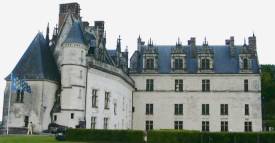Château d'Amboise

The Château d'Amboise sits on a
strategic promontory over the River
Loire. In the eleventh century there was
a ford across the Loire at this point
and the first serious castle was built
to guard the ford by Fulk Nerra ('Fulk
the Black') who was every bit as scary
as his name suggests. Fulk's castle was
added-to over the centuries and by 1492
it was in the hands of Charles VIII 'The
Affable' (who was, in fact, fairly
affable, at least compared to Fulk.) It
was Charles who began the major refurb
of Amboise in the
French-Late-Gothic-Flamboyant style we
see today. Sadly for Charles, he never
saw the building work completed: in
1498, he hit his head on a low doorway
in Amboise and died of concussion.
King François I saw the work completed in
1515, including the impressive formal
gardens and intricately-carved Chapel of
Saint-Hubert. François invited many guests
to Amboise, including painter, inventor and
all-round polymath Leonardo da Vinci. He
housed Leonardo in the Clos Lucé, a town
house connected to the Château by an
underground passage. Leonardo spent the last
three years of his life here, and today you
can see models of some of his extraordinary
inventions, including a man-powered,
single-occupant military tank that looks
remarkably like a Dalek.
For his patron François, meanwhile, Leonardo was commissioned to make a mechanical lion, which could walk forward and open its chest to reveal a cluster of lilies - hardly a serious use of so great a talent, but hey, that's kings for you.Your guide at Amboise will probably tell you that Leonardo is buried in the Chapel of Saint-Hubert. All they really found, during excavations in the 1860s, was a skeleton and fragments of a stone inscription containing some of the letters of Leonardo da Vinci's name - so it might actually be the grave of Vince Dodo.
 Mary
Queen of Scots grew up in Amboise. A
political hot potato even at the age of
five, she was spirited away from Scotland by
Henri II who intended she should one day
marry his three year-old son François and
unite the kingdoms of Scotland and France.
It seems the toddlers hit it off straight
away, and ten years later, they were married
at Notre-Dame in Paris. Whilst at Amboise,
Mary learnt French, Italian, Spanish, Latin,
Greek, music (two instruments,) poetry,
prose, horsemanship, falconry and
needlework. She probably didn't learn them
from King Henri, who was frequently away on
'business trips' (i.e. seeing his mistress
Diane of Poitiers in the Château de
Chenonceau).
Mary
Queen of Scots grew up in Amboise. A
political hot potato even at the age of
five, she was spirited away from Scotland by
Henri II who intended she should one day
marry his three year-old son François and
unite the kingdoms of Scotland and France.
It seems the toddlers hit it off straight
away, and ten years later, they were married
at Notre-Dame in Paris. Whilst at Amboise,
Mary learnt French, Italian, Spanish, Latin,
Greek, music (two instruments,) poetry,
prose, horsemanship, falconry and
needlework. She probably didn't learn them
from King Henri, who was frequently away on
'business trips' (i.e. seeing his mistress
Diane of Poitiers in the Château de
Chenonceau).
After the heydays of the sixteenth century, Amboise fell into disfavour and disrepair. Much was demolished during the Revolution, under Napoleon and during the Second World War. Today, you see about one fifth of what would have been there in François' time. The present owner is Henri, Comte de Paris, direct descendent of the last French king Louis-Philippe, and therefore pretender to the French throne - should he want the job.
Amboise is open every day of the year (except Christmas Day and New Year's Day) and admission costs only 9 €. When you visit, watch those low doorways.